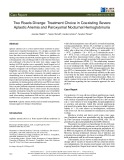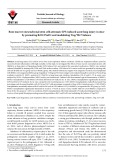
Bone marrow failure syndrome
-
Myelodysplastic/myeloproliferative neoplasms (MDS/MPN) comprise several rare hematologic malignancies with shared concomitant dysplastic and proliferative clinicopathologic features of bone marrow failure and propensity of acute leukemic transformation, and have significant impact on patient quality of life.
 15p
15p  vialfrednobel
vialfrednobel
 23-12-2023
23-12-2023
 6
6
 4
4
 Download
Download
-
Aplastic anemia (AA) is a bone marrow failure syndrome of pancytopenia due to impaired hematopoiesis. It is strongly associated with paroxysmal nocturnal hemoglobinuria (PNH). Each condition can cause the other, or occur simultaneously. There are no guidelines for treating concomitant AA and PNH; immunosuppressive therapy (IST) or hematopoietic stem cell therapy (HSCT) is first-line for the former, and eculizumab is first-line for the latter.
 3p
3p  viintuit
viintuit
 26-09-2023
26-09-2023
 4
4
 0
0
 Download
Download
-
Part 1 book "Pediatric hematology - A practical guide" includes content: Normal hemopoiesis and the physiology of blood, the coagulation system; common laboratory tests used in hematology and how to interpret them; reference ranges in children, neonatal anemia, neonatal thrombocytopenia, neonatal bleeding disorders, neonatal thrombotic disorders, inherited bone marrow failure syndromes,... and the contents.
 161p
161p  oursky03
oursky03
 28-08-2023
28-08-2023
 4
4
 1
1
 Download
Download
-
Acute lung injury (ALI) and its severe form acute respiratory distress syndrome (ARDS) are respiratory failures caused by excessive alveolar inflammation with high mortality. In this study, we investigated the effects of bone marrow mesenchymal stem cells (BMSCs) on lung injury of lipopolysaccharide (LPS)-induced ALI and explored the associated mechanisms. BMSCs were isolated, cultured, identified by staining with CD34 and CD44 surface markers.
 13p
13p  lyhuyenthu
lyhuyenthu
 31-01-2023
31-01-2023
 3
3
 2
2
 Download
Download
-
Acute respiratory distress syndrome (ARDS) is among the most common causes of respiratory failure in critically ill patients. Despite extensive research, ARDS remains a major cause of morbidity and mortality, with no effective pharmacological treatment options. The present study was conducted to evaluate the efficacy of bone marrow-derived stem cells (BM-MSCs) compared with Dexamethasone (Dex) and Sodium bicarbonate (NaHCO3) against acute lung injury (ALI) induced by lipopolysaccharide (LPS) in rats.
 15p
15p  chauchaungayxua5
chauchaungayxua5
 05-05-2020
05-05-2020
 20
20
 1
1
 Download
Download
-
The hypoproliferative anemias are normochromic, normocytic or macrocytic and are characterized by a low reticulocyte count. Deficient production of RBCs occurs with marrow damage and dysfunction, which may be secondary to infection, inflammation, and cancer. Hypoproliferative anemia is also a prominent feature of hematologic diseases that are described as bone marrow failure states; these include aplastic anemia, myelodysplasia (MDS), pure red cell aplasia (PRCA), and myelophthisis.
 25p
25p  ozon_ozon
ozon_ozon
 26-04-2012
26-04-2012
 55
55
 3
3
 Download
Download
-
Pure Red Cell Aplasia: Treatment History, physical examination, and routine laboratory studies may disclose an underlying disease or a suspect drug exposure. Thymoma should be sought by radiographic procedures. Tumor excision is indicated, but anemia does not necessarily improve with surgery. The diagnosis of parvovirus infection requires detection of viral DNA sequences in the blood (IgG and IgM antibodies are commonly absent). The presence of erythroid colonies has been considered predictive of response to immunosuppressive therapy in idiopathic PRCA.
 8p
8p  thanhongan
thanhongan
 07-12-2010
07-12-2010
 56
56
 5
5
 Download
Download
-
Epidemiology Idiopathic MDS is a disease of the elderly; the mean age at onset is 68 years. There is a slight male preponderance. MDS is a relatively common form of bone marrow failure, with reported incidence rates of 35 to 100 per million persons in the general population and 120 to 500 per million in the elderly. MDS is rare in children, but monocytic leukemia can be seen. Therapy-related MDS is not age-related and may occur in as many as 15% of patients within a decade following intensive combined modality treatment for cancer. Rates of MDS have increased over time,...
 5p
5p  thanhongan
thanhongan
 07-12-2010
07-12-2010
 76
76
 5
5
 Download
Download
-
Bone Marrow The bone marrow is usually normal or hypercellular, but in 20% of cases it is sufficiently hypocellular to be confused with aplasia. No single characteristic feature of marrow morphology distinguishes MDS, but the following are commonly observed: dyserythropoietic changes (especially nuclear abnormalities) and ringed sideroblasts in the erythroid lineage; hypogranulation and hyposegmentation in granulocytic precursors, with an increase in myeloblasts; and megakaryocytes showing reduced numbers or disorganized nuclei.
 4p
4p  thanhongan
thanhongan
 07-12-2010
07-12-2010
 74
74
 4
4
 Download
Download
-
Myelodysplasia: Treatment The therapy of MDS has been unsatisfactory. Only stem cell transplantation offers cure: survival rates of 50% at 3 years have been reported, but older patients are particularly prone to develop treatment-related mortality and morbidity. Results of transplant using matched unrelated donors are comparable, although most series contain younger and more highly selected cases.
 8p
8p  thanhongan
thanhongan
 07-12-2010
07-12-2010
 72
72
 4
4
 Download
Download
-
Hematopoietic Stem Cell Transplantation This is the best therapy for the young patient with a fully histocompatible sibling donor (Chap. 108). Human leukocyte antigen (HLA) typing should be ordered as soon as the diagnosis of aplastic anemia is established in a child or younger adult. In transplant candidates, transfusion of blood from family members should be avoided so as to prevent sensitization to histocompatibility antigens; while transfusions in general should be minimized, limited numbers of blood products probably do not seriously affect outcome.
 5p
5p  thanhongan
thanhongan
 07-12-2010
07-12-2010
 64
64
 4
4
 Download
Download
-
Persistent Parvovirus B19 Infection Chronic parvovirus infection is an important, treatable cause of PRCA. This common virus causes a benign exanthem of childhood (fifth disease) and a polyarthralgia/arthritis syndrome in adults. In patients with underlying hemolysis (or any condition that increases demand for red blood cell production), parvovirus infection can cause a transient aplastic crisis and an abrupt but temporary worsening of the anemia due to failed erythropoiesis.
 5p
5p  thanhongan
thanhongan
 07-12-2010
07-12-2010
 60
60
 4
4
 Download
Download
-
Outcomes following both transplant and immunosuppression have improved with time. High doses of cyclophosphamide, without stem cell rescue, have been reported to produce durable hematologic recovery, without relapse or evolution to MDS, but this treatment can produce sustained severe fatal neutropenia and response is often delayed. New immunosuppressive drugs in clinical trial may further improve outcome.
 5p
5p  thanhongan
thanhongan
 07-12-2010
07-12-2010
 66
66
 3
3
 Download
Download
-
Definition and Differential Diagnosis PRCA is characterized by anemia, reticulocytopenia, and absent or rare erythroid precursor cells in the bone marrow. The classification of PRCA is shown in Table 102-4. In adults, PRCA is acquired. An identical syndrome can occur constitutionally: Diamond-Blackfan anemia, or congenital PRCA, is diagnosed at birth or in early childhood and often responds to glucocorticoid treatment; a minority of patients have etiologic mutations in a ribosomal RNA processing gene called RPS19.
 5p
5p  thanhongan
thanhongan
 07-12-2010
07-12-2010
 74
74
 3
3
 Download
Download
-
Pathophysiology Bone marrow failure results from severe damage to the hematopoietic cell compartment. In aplastic anemia, replacement of the bone marrow by fat is apparent in the morphology of the biopsy specimen (Fig. 102-1) and MRI of the spine. Cells bearing the CD34 antigen, a marker of early hematopoietic cells, are greatly diminished, and in functional studies, committed and primitive progenitor cells are virtually absent; in vitro assays have suggested that the stem cell pool is reduced to ≤1% of normal in severe disease at the time of presentation. Figure 102-1 A.
 5p
5p  thanhongan
thanhongan
 07-12-2010
07-12-2010
 72
72
 5
5
 Download
Download
-
Immune-Mediated Injury The recovery of marrow function in some patients prepared for bone marrow transplantation with antilymphocyte globulin (ALG) first suggested that aplastic anemia might be immune-mediated. Consistent with this hypothesis was the frequent failure of simple bone marrow transplantation from a syngeneic twin, without conditioning cytotoxic chemotherapy, which also argued both against simple stem cell absence as the cause and for the presence of a host factor producing marrow failure. Laboratory data support an important role for the immune system in aplastic anemia.
 5p
5p  thanhongan
thanhongan
 07-12-2010
07-12-2010
 78
78
 4
4
 Download
Download
-
Bone Marrow The bone marrow is usually readily aspirated but dilute on smear, and the fatty biopsy specimen may be grossly pale on withdrawal; a "dry tap" instead suggests fibrosis or myelophthisis.
 5p
5p  thanhongan
thanhongan
 07-12-2010
07-12-2010
 74
74
 4
4
 Download
Download
-
Harrison's Internal Medicine Chapter 102. Aplastic Anemia, Myelodysplasia, and Related Bone Marrow Failure Syndromes Aplastic Anemia, Myelodysplasia, and Related Bone Marrow Failure Syndromes: Introduction The hypoproliferative anemias are normochromic, normocytic or macrocytic and are characterized by a low reticulocyte count. Deficient production of RBCs occurs with marrow damage and dysfunction, which may be secondary to infection, inflammation, and cancer.
 5p
5p  thanhongan
thanhongan
 07-12-2010
07-12-2010
 72
72
 4
4
 Download
Download
-
Aplastic Anemia Definition Aplastic anemia is pancytopenia with bone marrow hypocellularity. Acquired aplastic anemia is distinguished from iatrogenic marrow aplasia, marrow hypocellularity after intensive cytotoxic chemotherapy for cancer. Aplastic anemia can also be constitutional: the genetic diseases Fanconi's anemia and dyskeratosis congenita, while frequently associated with typical physical anomalies and the development of pancytopenia early in life, can also present as marrow failure in normal-appearing adults.
 6p
6p  thanhongan
thanhongan
 07-12-2010
07-12-2010
 82
82
 3
3
 Download
Download
-
Radiation Marrow aplasia is a major acute sequela of radiation. Radiation damages DNA; tissues dependent on active mitosis are particularly susceptible. Nuclear accidents can involve not only power plant workers but also employees of hospitals, laboratories, and industry (food sterilization, metal radiography, etc.), as well as innocents exposed to stolen, misplaced, or misused sources.
 6p
6p  thanhongan
thanhongan
 07-12-2010
07-12-2010
 57
57
 3
3
 Download
Download
CHỦ ĐỀ BẠN MUỐN TÌM
































